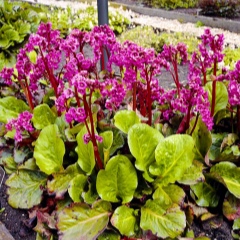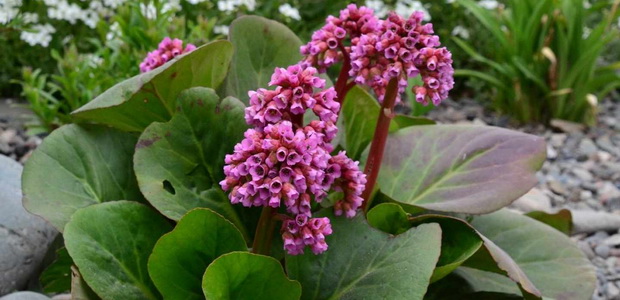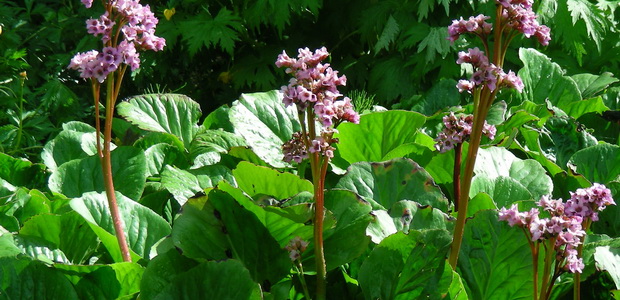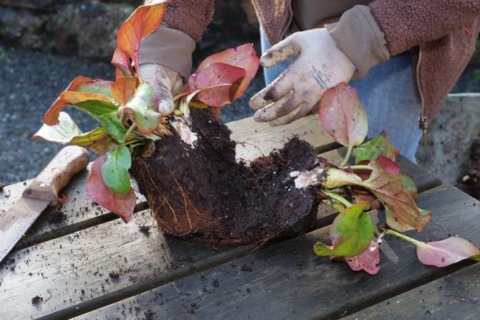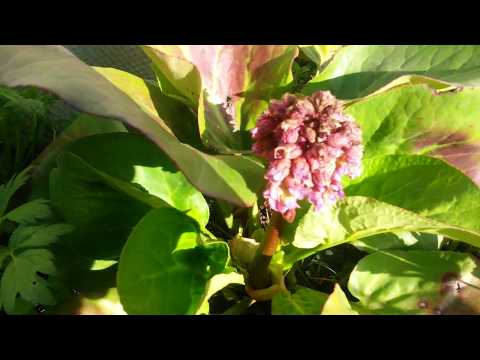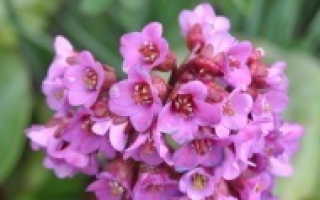Features of caring for incense in the garden
Badan care, due to its unpretentiousness, is simple
It is important to remember that the plant does not tolerate overdried soil, so watering should be regular and abundant. Do not remove the lower leaves that have lost their decorative effect - they cover the roots of the berry and help to retain moisture
If the desire to clean the sockets is great, you should mulch the soil around the plant.
Badan blooms in April-May - the timing and duration depend on the variety. Faded arrows are cut with scissors, if there is no need to get seeds from the plant. Under favorable conditions, re-flowering is possible in late August or September.
The overgrown badan densely covers the ground with its foliage, it is not for nothing that it is considered a ground cover plant. Where this flower grows there are no weeds, which means there is no struggle in the form of weeding either.

Weeds do not grow under overgrown berry leaves
Fertilizing badan is practically not needed - the overfed plant begins to fatten and blooms worse. Once a summer, after flowering, you can feed the plantings with a diluted complex fertilizer.
In the fall, remove old, dead leaves of bergenia. You should not try to cut them off with scissors or a knife, it is better to carefully cut them off without leaving a petiole.
Badan does not tolerate a transplant, so you should not touch it without special need. It grows well in one place for 10-12 years, expanding in breadth. It is necessary to take into account this feature of it when planning plantings, since growing, bergenia can be aggressive towards other plants. To prevent this from happening, it may be worth limiting its spread with curbs or stones.
Preparing for winter
Badan is quite frost-resistant - almost all of its varieties can withstand temperatures as low as -35–40 ° C, but under snow. In snowless winters, roots located close to the surface may freeze slightly. To prevent this from happening, you should take care of the shelter. For these purposes, dry fallen leaves or straw, pressed on top by spruce branches, are perfect. In the spring, it is necessary to remove the shelter, without waiting for the appearance of above-zero temperatures, otherwise the badan can support.

The reddened leaves of badan warn of the approach of winter
In areas with mild winters, where -10оС is the maximum decrease, the badan does not need shelter.
Possible problems of the beginner grower
Badan is a non-capricious plant and almost does not cause trouble to its owners. The plant is almost not affected by insects and diseases, therefore it does not require preventive treatments.
Lack of flowering can be a problem. In this case, you should check the fulfillment of all agrotechnical conditions. If the berry grows well, but does not bloom, it may lack sunlight, since it is planted in full shade.
The lethargy and yellowing of the berry leaves may indicate stagnant water when the roots are in sour soil. This happens if the plant is planted in a clayey area without drainage. To save the sockets, it is necessary to transplant them, not forgetting to rinse the roots in a solution of potassium permanganate.
Use in landscape design
Badan has been cultivated in the middle of the 18th century. Garden forms of this perennial are widespread in Europe. The original outlines of the bushes, an interesting shape and rich colors of leaves and inflorescences allow you to create picturesque compositions.
Badan in landscape design
The plant has a decorative appearance from early spring to frost:
in spring, the bushes of badan are decorated with numerous inflorescences with bright flowers
in summer, its luscious foliage serves as an excellent background for other flowering plants - irises, daylilies, phloxes, bluebells, asters, doronicum, Gaillardia, alyssum
in September, the badan leaves change their green color to a colorful autumn scale, and the plants again come to the fore, attracting attention with bright colors
even with the onset of winter, the leaves remain fresh, leaving in this form under the snow
Different varieties of badan react differently to the onset of cold weather. This manifests itself in a different change in the color of the leaves in late autumn. In some varieties, the edges of the leaves darken first, becoming brighter with a decrease in temperature. For others, the red border turns into bizarre stains, and for others, the entire leaf plate immediately becomes crimson, orange or crimson.
In Russia, badan is rarely used as an ornamental plant. And in vain: it looks great in plantings that mimic the natural landscape: on the banks of reservoirs, in alpine slides and rocky gardens. Badan is good as a border plant.
Groups of the same type of varieties look great against the background of well-groomed lawns. Berry goes well with ferns, conifers and ground cover plants. Its large, round leaves make harmonious combinations with plants that have narrow and split foliage.
VIDEO: Evergreen BADAN - HEALING PROPERTIES, GROWING, CARE, REPRODUCTION
Badan: description, types and varieties, planting and care in the open field, medicinal properties and contraindications (60+ Photos & Videos) + Reviews
Description of the plant
Large dark green leathery berry leaves are collected in a basal rosette. With the onset of autumn, they begin to acquire reddish, brown, orange or crimson shades, giving the plant colorfulness and exceptional decorativeness. First, the veins of the leaf turn red, then its edges, and then the entire leaf plate.

Badan flowers
In a picturesque autumn garden, such an attractive plant will definitely not go unnoticed. On the contrary, badan will serve as a magnificent decoration of the personal plot. Even ornamental leaves alone are enough to make a choice in favor of planting incense in the garden. But this plant also blooms beautifully!
Badan will always stand out from other plants in the garden. Badan flowers can be white or all shades of pink, raspberry and lilac. They are collected in loose paniculate inflorescences on thick leafless peduncles that appear in early spring among the leaves and continue to grow in height even during flowering. Badan blooms in spring - early summer. Flowering lasts for two to three weeks.
This plant is drought-resistant and frost-resistant, and its shiny succulent leaves badan keeps green even under a layer of snow. The thick rhizome grows horizontally and is located at a shallow depth. Therefore, the perennial grows in breadth, forming picturesque thickets, and can be aggressive for nearby plants.
Badan can be considered a long-liver. In one place without transplanting, this perennial grows and feels good for 10-15 years and even more. However, it is recommended to divide the bushes after 4-5 years: this contributes to their vigorous growth and lush flowering.

General view of the plant
To date, ten types of badan are known, which are common in the wild in the temperate climate of Asia. They grow mainly in mountainous regions over a vast territory from Central Asia to China and Korea, including the southern part of Siberia and the Far East, Afghanistan, northern Mongolia and the Himalayas.
The natural habitats of plants are alpine meadows and poor soils of rocky taluses and mountain slopes. Among the varieties of badan, there are annual plants, however, most of the species are evergreen perennials.
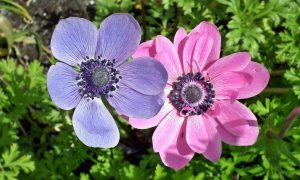
Anemones: 25 species, features of reproduction and care, planting in open ground, forcing in winter, description of the medicinal properties of the plant (50+ Photos & Videos) + Reviews
Reproduction methods
Badan thick-leaved propagates in 4 main ways: seeds, cuttings, division and root shoots. However, it is the first method that is most often used, since it is considered the most effective. The second most popular is cuttings - in this case, cuttings are cut from healthy and viable shrubs. As a material for propagation, a piece of the root system is used, which has 3-5 buds, as well as a leaf rosette with a couple of three leaves. They are planted in sand, which is best placed in a special greenhouse. Only 3-5 cm goes deep into the stalk. In principle, in some situations, you can simply separate a part of the rhizome with a shovel and transplant it into a new place, and fill the vacated area with compost.
If we are talking about seeds, then it is customary to collect them in September. It is convenient to store the seed material of thick-leaved bergenia in paper bags, signed with the indication of the variety and date of collection
It is important that the bags are kept at room temperature. In February, the seeds are laid out on clean paper and processed with an electrified glass or ebonite stick, maintaining a height of 1 centimeter
This action is repeated a couple of times with constant stirring of the seeds.
In March, you can start growing seedlings. The soil for it should be prepared in advance - in the fall. The mixture is made up of humus and compost, taken in equal amounts, enriched with some components. As a rule, the contents of one bucket must be enriched with a couple of glasses of wood ash, 20 grams of potassium sulfate, and 60 grams of superphosphate. An alternative is a greenhouse mixture sold in specialty stores. Somewhere 2-3 weeks before planting, the mixture is also supplemented with peat or a nutrient mixture for violets.
You can grow seedlings either in a wooden or in a plastic container equipped with holes in the bottom and having low sides. Seeds should first be placed in a solution for better germination. To do this, a tablespoon of ash, a pinch of copper sulfate and a pinch of boric acid are dissolved in a liter of hot water. The seeds are placed in a gauze bag, after which they are dipped into the resulting liquid overnight. In the morning they will need to be dried, and the soil will be poured with a solution of potassium permanganate.
The pits are made simply with your finger, keeping an equal gap between the individual indentations and not going deeper than 1 centimeter. The decomposed seeds are sprinkled with fine sand or soil, after which they are abundantly irrigated. The containers are tightened with cling film and put away in a well-heated place, for example, to a battery. Planting thick-leaved berry must be watered and ventilated, and then the seedlings will hatch pretty soon. The appearance of the first is accompanied by the removal of the film and the transfer of containers to the light.
How to care for a plant outdoors
Growing and caring for badan does not require special attention, the flower is not at all capricious. The main thing is to keep the soil moist and loose.
Badan loves loose fertile soil, where there will be no stagnation of moisture. The acidity level should be lowered. Alkalinity, on the other hand, is slightly overestimated. You can add a little lime to the soil to increase the alkali level.
On rainy days, shrubs do not need to water
During dry periods, it is important to let the flower saturate with moisture, otherwise it will get sick. Irrigation water should be at room temperature, cold water promotes stagnation of moisture and the formation of fungal diseases
The first time after planting, it is important to provide special care for the badan. Watering for the first time is carried out only after the formation of the first buds, the next time - at the very peak of flowering, the third watering - when all the buds have faded
From time to time you need to carefully loosen the soil, trying not to damage the soil.

During the flowering period, you do not need to disturb the bush once again.
In the spring and autumn, it is necessary to remove rotten and dried leaves, stems and buds. In the spring, mineral fertilizers are applied, and in the fall, organic and mineral dressings are made.
During flowering, care is suspended, which will disturb and injure the bush. During this period, it is necessary to monitor the lighting of the bushes - it should be moderate. Badan blooms well in illuminated areas.
Important! It is imperative to avoid strong drafts during flowering. The plant is very frost-hardy, so it does not need shelter.
However, flower growers notice that after winter shelter with spruce branches, berry blossoms more abundantly, begins to grow faster and sooner awakens after wintering.
The plant is very hardy and therefore does not need shelter. However, flower growers notice that after winter shelter with spruce branches, berry blossoms more abundantly, begins to grow faster and sooner awakens after wintering.
Berry care in the garden
Most often, subject to the rules of agricultural technology, growing badan in open soil does not cause any particular trouble to the gardener. In spring, after the snow cover has melted, all the foliage that has suffered during the winter should be cut from the bushes. Also at this time, pruning of overgrown stems and feeding with complex mineral fertilizer are carried out. The plant is re-fed half a month after the end of flowering, at this time the growth of new foliage should begin. For feeding badan, a solution of Kemira-kombi fertilizer is suitable (1 tablespoon for 1 bucket of water). For 1 square meter of a flower bed, 5 liters of such a solution are taken.
Watering
In order for a flower to grow and develop normally, it must be properly watered. The first time the bushes are watered after the buds begin to form, the second - during flowering, and the third - after 15–20 days, as the plants will fade. However, it is necessary to water badan only if the season is dry. If it rains regularly, then the flowers will have enough natural precipitation.
The roots of such a flower from overheating and drying out in nature protect its lower leaf plates, which eventually die off and fly around. But when grown in the garden, in order to preserve the decorative effect of the bushes, the leaf plates that have begun to die off are cut off along with the petioles, and the soil surface is covered with a layer of mulch.
Reproduction by dividing the bush
Badan can be propagated not only by seeds, it can also be done by dividing the bush. The overgrown bush forms young rosettes with its own root system, which is very close to the soil surface. That is why it is very easy to dig up and transplant a young rosette without injuring the parent plant. You can only share a healthy, well-developed, middle-aged bush with large leaf plates, while the leaf rosette is separated along with the heel. Make sure there are three or more buds on each rhizome section. The division is carried out after the bushes have faded: in May – August. Only 2 or 3 of the youngest leaf plates should be left on the cut off outlet, and all the rest are cut off. They are planted in pre-prepared planting holes, while they need to be buried in the soil by 30-50 mm, and the distance between the divisions should be from 30 to 40 centimeters. The planted cuttings take root quickly. During the first year after transplanting, the rosette grows foliage, and a young bush will bloom only for 2 or 3 years of growth.
Luxurious Badan! Cultivation and reproduction
Transfer
A bush can grow in the same place for several decades. Badan does not need frequent transplants. Over time, it can greatly expand in breadth and begin to displace other cultures. That is why it is recommended to transplant the flower to a new place once every 5 or 6 years.
The transplant is carried out together with the division of the bush from early to mid-September. During the planting of parts of the bush, the distance between them should be at least 30 centimeters.After transplanting, during the first 15 days, the badan needs abundant watering.
Diseases and pests
Badan has a very high resistance to both pests and diseases. However, with regular stagnation of water in the root system, the flower can infect a fungal disease, namely, ramulariasis. In the affected bushes, brown specks are formed on the front surface with a pale red border, and on seamy surface of foliage a subtle whitish bloom appears. Over time, the affected foliage begins to dry out. All diseased foliage is cut off, and the bush is sprayed with a Fundazol solution or a copper-containing agent, for example, copper oxychloride, Bordeaux mixture or copper sulfate.
If the flower is grown in a shaded area, then nematodes or a slobbering penny can settle on it. In order to get rid of the penny, the bushes are sprayed twice with a solution of Aktara or Aktellik with a break of 7 days. A dry, fine day is chosen for processing, while the air temperature can vary from 21 to 28 degrees (not higher or lower). Getting rid of a nematode is quite difficult. To begin with, the affected bushes are removed from the ground, and their rhizomes are immersed in a strong solution of potassium manganese for 30 minutes. Then the plant is transplanted to a new place, and the infected soil on the site must be treated several times with insecticidal preparations. It will be possible to plant something in this area after at least 1 year after the end of the treatments.
What a badan flower
Badan (bergenia) is a herbaceous plant with a creeping rhizome, thanks to which it quickly grows and covers the unsightly territories of the garden with its large rounded leaves. It successfully displaces weeds, and not only with its rhizome, but also with a spreading rosette that creates a thick shadow. At the same time, the butt is low - usually up to 40 cm, it gets along well with other ground cover plants and flowers.
Bodan is decorative all year round:
-
From May to early summer, it is decorated with panicles of inflorescences. The height of the peduncle and the shade of the corollas depend on the variety, the main colors are: white, pink, lilac, violet. Badan's brooms look good against the background of forget-me-nots, tulips, doronicum and other plants blooming at the same time.
- In summer, after flowering, wide leaves are beautifully combined with xiphoid in iris, openwork in fern, carved in Volzhanka, etc.
-
In the fall, having been under the first frosts, the badan rosettes themselves turn into flowers, turning into a raspberry, lilac or purple color. Interestingly, the leaves of many varieties remain alive even under the snowdrifts.
Over time, the old leaves die off, undergo natural fermentation and turn into a healing tea. For medicinal purposes, it is the old, already dried, brown leaves that are brewed. In Altai, the drink is called Chigir tea. It has a tonic and antibacterial effect, normalizes blood pressure, removes kidney stones.

For tea, collect the lower, dried leaves
Popular species and varieties
Vergenia crassifolia is a thick-leaved badan, also known by the names: early flower, Mongolian and Chagyr tea. The species is widespread in mountainous and taiga areas of Siberia, and in Altai it is a technical medicinal plant. Also, thick-leaved incense grows wild in China, Korea, Mongolia, Kazakhstan.
The leaves of this species are juicy, green, obovate, in autumn they turn purple-red. But they appear in the spring only after the growth of the peduncle. Corollas at its top are collected in dense inflorescences, depending on the variety, they are pale pink (Giderruspe variety), purple (Purpurea), lilac (Senior). The height of the thick-leaved bergenia bush is 40-60 cm, it blooms in May-June for 3-4 weeks.
Video: what thick-leaved berry looks like and how it is useful
Vergenia cordifolia, or heart-leaved badan, originally from Altai, is a variety of thick-leaved.The height of the rosette is 40 cm, blooms for 3 weeks in May with pink or purple inflorescences inclined to the ground. The leaves of this species are dark green, hibernate under the snow until spring.

This badan got its name from the shape of its leaves.
Vergenia ciliate - ciliated badan, common in the forests and on the mountain ledges of the Himalayas, in Tibet, for this it is called the Himalayan. The rosette leaves are almost round, up to 35 cm in diameter, covered with cilia at the edges and on the back, and often remain smooth on the front, in the center of the leaf. In our climate, sockets freeze in winter, but grow back in spring. Berry blossoms with pale pink corollas.

Leaves and petioles of ciliate berry are covered with pubescence
Types and varieties of badan
The following types and varieties of badan are grown in culture:
Badan Strechi (Vergenia stracheyi = Vergenia gorbunowii)
In nature, it grows on the moist rocks of Central Asia, Afghanistan, the Himalayas and China, sometimes it is found at an altitude of up to 3000 m above sea level. At first, this species was named in honor of the leader of the expedition to the Western Pamir region Gorbunov, but later it was given a different name. Badan Strechi is a living relic. It has ovoid oblong glossy ciliate leaves with coarse teeth along the edge. The leaves are 8-10 cm long and 3-5 cm wide. They keep well under the snow. Lilac-pink or white flowers up to 15 mm long on peduncles up to 40 cm high collected in racemose inflorescences. Badan Strech blooms in July-August.
The best varieties of this type:
- Belvedere is a miniature plant up to 20 cm high with leaves 4-6 cm long and white, gradually turning pink flowers;
- Beethoven - a variety up to 40 cm high with snow-white flowers, pink peduncles and brown calyces;
- Alba is a natural form with white flowers.
Badan thick-leaved (Vergenia crassifolia)
He is badan medicinal, he is Mongolian tea, he is Chagyr tea, he is early flower. This amazing plant grows in Transbaikalia, Altai, Sayan Mountains, Kazakhstan, Northern Mongolia, China and Korea, choosing rocky slopes and cedar forests at an altitude of 700 to 2500 m above sea level.
This is an evergreen herbaceous perennial with a powerful creeping and branched rhizome and two types of shoots - rosette vegetative and leafless flowering, reaching a height of 40 cm at fruiting.The leaves of vegetative shoots are large, leathery, glossy, obovate, bright green, by autumn acquiring fiery red tint.
Bell-shaped flowers with white, pink-lilac or lilac-purple petals up to 12 mm long are collected in dense inflorescences. Flowering begins in June and lasts 3-4 weeks. They use bergenia medicinal for leather dressing, and for tea they collect withered old leaves that have overwintered under the snow. The best decorative varieties of thick-leaved badan are:
- Senor - a bush up to 40 cm high with lilac-pink flowers;
- Giderruspe is a plant up to 60 cm high with pale pink flowers collected in inflorescences up to 20 cm long. The flowering of this variety lasts almost two months;
- Purpurea is a bush up to half a meter high, with purple-red flowers up to 1 cm in diameter.
Bergenia cordifolia (Vergenia cordifolia)
The plant is up to 40 cm high, an intraspecific variety of thick-leaved bergenia. The berry leaf is rounded, rough texture, dark green in color. Bell-shaped, deep pink or lilac flowers, collected in inclined brushes, bloom in May. There are varieties with lavender and white flowers. The plant has been cultivated since 1779;
Badan Hissar (Vergenia hissarica)
Endemic of the Gissar ridge, the rarest relict species. The rhizome in plants of this species is powerful, leaves are rosette, basal, obtuse, oblong, obovate, glabrous, dull, densely ciliate along the edge. Peduncle up to 20 cm high. White or barely pinkish flowers are collected in 6-8 pieces in a one-sided raceme;
Badan hybrid (Vergenia x hybrida)
This species includes the most commonly grown hybrids:
- Abenglut is a bush up to 30 cm high with bright green leaves, which turn bronze-brown in autumn, and bright purple, sometimes double flowers;
- Frau Holle is a variety with snow-white flowers and marsh-colored leaves, the petioles of which become bright purple in cold weather;
- Schneekenigin is a plant up to 50 cm high with large round leaves with wavy edges and high purple peduncles, on which large white cupped flowers open, gradually turning pink. The variety is grown for cutting;
- Morgen Rote is a variety that blooms twice a season with bright pink flowers collected in branched racemose inflorescences;
- Baby Doll is a bush up to 30 cm high with beautifully shaped flowers of pale pink color, gradually turning into dark cream.
In addition to those described, hybrids of Badan Sieberlicht, Glockenturm, Ballouly, Bassingham White, Sunshade, Magic Giant, Walter Kinley, Sunningdale, Eroica, Pink Dragonfly and varieties named after the great composers, Barth, Barthrum ...
In culture, there are also species of ciliate, pacific, Schmidt and Ugam.
Species features
In total, the plant has 10 species, many varieties have been bred on their basis. But the most common are three varieties.
Table. Types of badan
| Type of badan | Features and short description |
|---|---|
|
Thick-leaved |
It grows up to 50 cm in height, the leaves are juicy and large. The flowers smell nice, the inflorescences are pink. In nature, it grows on rocky slopes. Inflorescences appear immediately after the snow melts one of the first, the flowering time is no more than a month. The plant is adapted to growing in regions with unfavorable climatic conditions. |
|
Pacific |
Rhizomes are highly developed, because of the rocky soil they rise above the ground. The height of the Pacific berry is about 40 cm, lilac flowers resemble bells in shape, flowering from May to the end of June. Leaves with a diameter of 20 cm form dense thickets, green in summer and red in late autumn. |
|
Hearty |
The name is due to the shape of the leaves, which have dense flesh and feel great under a layer of snow. The flowering period is 20 days, but it can fluctuate depending on the specific weather conditions in the area. The flowers can be white or purple-white. |
Planting and breeding rules
It is best to plant or propagate a charming flower in early spring (at least in early autumn, but not later than mid-September). The soil is suitable for stony, sandy or light turf
Clay soils, which remain moist for a long time, are not suitable for the plant (it is important to remember that in the wild, badan grows on mountain slopes). Partial shade and lack of drafts - this is the ideal place for a Siberian guest
Before planting, the earth should be dug to the depth of the bayonet of the shovel, and the weeds should be collected and burned. Having dug a not too deep hole with a diameter of 25-30 cm and slightly fertilized it with wood ash, you need to place the roots of the flower on the bottom, sprinkle it with earth and pour it over with settled water. You can immediately pour water into the hole, then lower the roots of the plant and then sprinkle with soil and tamp. Watering the berry is often not necessary, it is enough once a week on especially dry days.
Particularly patient gardeners can try to grow unpretentious flowers from seeds, this is not as difficult as it might seem at first glance. Yes, the seeds of the flowers are quite small, somewhat similar to the seeds of petunias, and they grow rather slowly, but the results obtained will delight for many years. All you need for this is light soil, a wide flowerpot and seeds of your favorite variety.
And you can plant without flowerpots, just sow seeds in open ground before the first frost and sprinkle with fallen dry leaves. In the spring, the first shoots will appear, and then a whole cycle of activities for the care of seedlings will begin.They need to be opened, watered and weed in time, make sure that pests and fungal diseases do not attack young flowers. In general, this is a laborious process.
Growing in pots is a little easier. In late autumn, when the first snow has already flown, you can start sowing. At the bottom of the flowerpot, you need to pour a rather thick layer of gravel or other stones for drainage, distribute the soil mixture on top, lightly tamp it and water it a little. Spread the seeds over the surface of the soil in a pot and sprinkle with a small amount of soil. And then put it in the garden, under the snow.
In the spring, as soon as the first shoots appear, the bowls can be brought into the house and, already in warmth and comfort, gently plant fragile rosettes so that they are not cramped. It is easier to care for young plants in the house, not like in the garden, and you can plant the roots in open ground the next year, when they get stronger.
An evergreen handsome badan, its reproduction can be carried out in three ways:
- seeds;
- dividing the rhizome;
- by cuttings.
Since the topic of seed reproduction is fully disclosed, and even a novice gardener can easily cope with the division of rhizomes, it's time to deal with the third method. So, how does the berry planting from cuttings take place? Cutting is best done after the plant has fully bloomed (from about the end of May to the end of September). The healthiest plant is chosen, and on it are the apical roots with rosettes of leaves.
Only a couple of the youngest leaves are left on the cuttings, all the rest are carefully cut off. All cuttings are planted in prepared moist soil at a short distance from each other (from 15 to 20 cm). After 1.5-2 weeks, the rooted cuttings release new leaves, it is a pity that they will bloom only after a year.
Propagation of badan
You can get young plants of badan on the site by sowing seeds of the variety you like or by dividing an already grown plant.
Seeds sown into grooves with a depth of no more than 0.5 cm of a furrow are embedded in moistened soil and sent to the cold. Ideally, if the planting container is taken out into the open air and covered with snow, which will maintain optimal humidity and prevent future seedlings from freezing.
In early March, the container is placed in a warm place, in the light, but not in direct sunlight. At a temperature of 18–19 ºC and maintaining high humidity, the seeds begin to swell and hatch in 20–25 days.
On this topic:
BACK
FORWARD
1 of 176
Caring for the berry flower after planting involves watering and carefully loosening the soil around the seedlings. If the passages are too dense, they are thinned out, leaving one plant at a time of 3-5 cm
In 45–55 days after sowing, young plants dive, spreading from each other at a distance of at least 6–7 cm. By June, you can determine where to plant badan. But before that, the seedlings are hardened, gradually increasing the residence time of the boxes with seedlings in the fresh air. In the first half of summer, the strongest seedlings are brought into the ground. The rest are transplanted in August.
Diseases and pests - badan
The Siberian plant suffers little from insects, but sometimes it picks up fungal infections in rainy and cool seasons. The most common disease is ramulariasis, which causes mottling and shrinking of the leaf blades. Sick foliage is cut out. During the period of active growth, the bushes are sprayed thoroughly with "Fundazol" or copper-containing agents.

The main pests of the badan plant:
- Slobbering penny - shoots and leaves infected with a pest are deformed, insects often spread diseases of thick-leaved bergenia. Pennitsa is destroyed by Aktara and Aktellik.
- Nematodes - strongly oppresses rhizomes. The plant must be dug up, the roots must be treated with strong potassium permanganate, the soil must be etched with insecticides.
Growing problems
Badan is resistant to various diseases and pests. Problems arise from improper care.
Why does not bloom berry, what to do in this case? A flowering plant should bloom in the summer for a month. If this does not happen, then there may have been a mistake in the landing or during the departure.
Excessive grooming can also hurt. During flowering, it is not necessary to disturb the flowers once again, as well as to feed them with fertilizers, especially in the composition of which there is nitrogen.
Leaves curl
Due to severe drought and prolonged exposure to the sun, the leaves of the bush may begin to turn yellow and curl. The problem may arise at the very peak of flowering, which is why many growers are perplexed: "Badan turns yellow in June, what should I do?" If no action is taken in time, the leaves will fall off along with the flowers.
It is necessary to monitor the quantity and quality of watering. Water the flower when the top layer of the soil dries up and spray the ground part of the bush during dry periods.
Pest and disease control
Very rarely, with abundant watering and unfavorable conditions, the flower can be affected by the fungus. The fight against infections is carried out with the help of special preparations of fungicides. You can use folk methods, but they are not as effective. With fungal diseases, the plant can completely die, so every minute is precious.
Important! Of the pests, berry is affected by the nematode and the slobbering penny. Nematoda - a worm that lives in the soil, lays eggs at the rhizomes and can kill the entire plant
The slobbering stump appears if the plant was planted in the shade. Pests, as well as diseases, must be fought with the help of chemicals.
Seat selection and landing
Badan can be planted in a wide variety of areas: in the shade and in open sunny places, on the banks of reservoirs and warmed up warm slopes. However, places located in light partial shade are best suited for a perennial. Plants may stop blooming in full shade.

Badan can be grown in different areas
The choice of location for this perennial plant should depend on the result you want to get. If berry is planted in partial shade, where moisture remains in the soil for a longer time, it will grow in a thick and juicy green carpet, but it will bloom quite modestly.
In areas warmed by the sun, the plant will delight you with lush flowering, but it will not be able to form powerful bushes with dense foliage and will have a somewhat depressed appearance. Badan growing in the sun requires regular watering.
Low-lying areas where water stagnates or groundwater is close to bed is completely unsuitable for growing badan. In this case, the roots of the plant can rot. Berry will grow best on light, fertile and moderately moist soils, neutral to slightly alkaline.
For planting seedlings and badan plots, shallow holes are made, on the bottom of which a little coarse river sand is poured for drainage. The plants are transferred together with a lump of earth and covered with soil. Watering must be done after planting.
Since badan grows well in the wild on poor rocky soils, you can try to make a similar soil in your area. To do this, usually mix 2 parts of sand, 2 parts of small stones and 1 part of sod land. Small amounts of gravel and sand can also be added to loamy soils.

Perennial Heuchera - when leaves are more important than flowers: description, planting in the open field, care (80+ Photos & Videos) + Reviews







